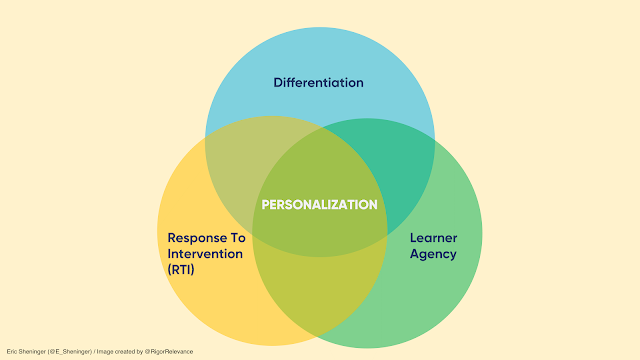Many concepts are looked upon negatively as they are associated with buzzwords, fads, or a lack of substance. You won’t get much of an argument from me as to the validity of this view because it is true in many cases. Educators want proven strategies that can be implemented readily that will address diverse learner needs while leading to an improvement in outcomes. Personalization is far from a fad or buzzword as it represents an equitable approach to learning. I shared the following definition in Disruptive Thinking in Our Classrooms:
Personalization constitutes pedagogical approaches that ensure all learners get what they need when and where they need it to succeed.
Personalization represents a shift in focus from the “what” (content, curriculum, tests, programs, technology) to the “who” to create a more personal learning experience for all kids. At the forefront is developing and sustaining a culture that imparts purpose, meaning, relevance, ownership, and various paths that cater to all students' strengths and weaknesses. Tools such as the Relevant Thinking Framework and technology can certainly assist, but what is more important is an emphasis on three core elements. While these are not new by any stretch, it is valuable to see how they seamlessly connect to create a personalized experience.
Learner agency
The underlying premise is to move learners from a state of engagement to empowerment so that they exert more ownership over their learning. To achieve this goal, they need to be granted more autonomy in the classroom and beyond. It is driven by high-agency strategies such as voice, choice, path, pace, and place. These aid in developing critical competencies needed for success in a disruptive world.
Differentiation
While not a new concept by any means, the challenge has always been with effective and consistent implementation. The overall premise is that instruction is tailored to better meet students' needs in the areas of content, process, and product. Whereas agency focuses more on what the learner is doing, differentiation is typically driven by the teacher. Ongoing assessment is vital as this provides the teacher with the necessary information to develop lessons and tasks that are more personalized. A simple Google search will unveil all the many strategies and techniques that are available to educators to make this a reality.
RTI
Response to Intervention (RTI) represents a multi-tiered process to identify the behavior and learning needs of struggling students early on and then provide specific support in the form of interventions. Components include:
- Tier 1 – Teacher provides research-based instruction to the entire class using extensive checks for understanding as a means of formative assessment. This data, and that collected through routine benchmarking, is utilized to determine what supports are needed in Tier 2. Behavior screenings are implemented as well.
- Tier 2 – Targeted supports using the data collected from the Tier 1 interventions are used to provide small-group instruction that focuses on specific learning and behavioral needs.
- Tier 3 – At this level, the most at-risk students are provided individualized support, typically in a one-on-one setting.
Data is a huge component as it influences the types of supports used in each tier above. For specific strategies that can be used in each tier, click HERE.
While digital tools, research on the brain, and an emphasis on high-agency strategies might be new, personalization is not. Developing an understanding of all the interconnected elements can assist you and others in creating experiences that meet the diverse needs of students while nurturing a positive school culture.

No comments:
Post a Comment